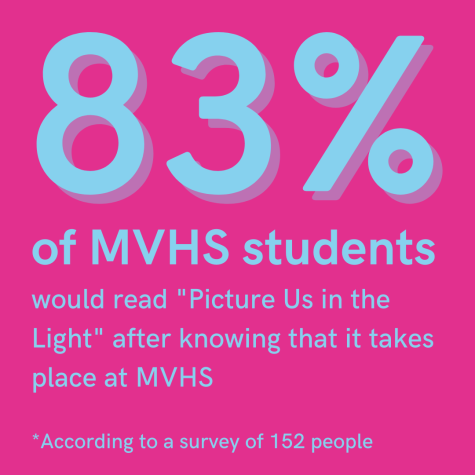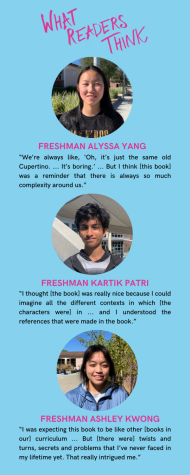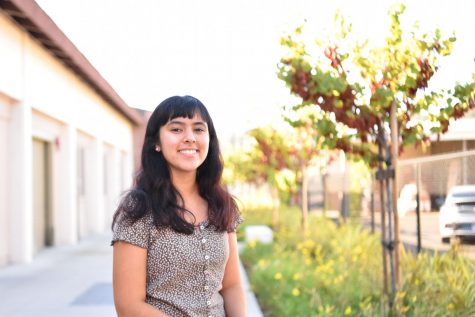Picture us here
Behind Kelly Loy Gilbert’s “Picture Us in the Light,” the novel that takes place at MVHS
“Picture Us in the Light” takes place at MVHS, following the life of protagonist Danny Cheng. Graphic | Sonia Verma
March 19, 2022
This story contains spoilers for “Picture Us in the Light” by Kelly Loy Gilbert
When MVHS alum ‘03 and author Kelly Loy Gilbert’s mother first read “Picture Us in the Light,” she told Gilbert that because of its setting, “only people from Cupertino [were] ever going to read this book.”
The novel, which was released in 2018, follows main character Danny Cheng, a senior at MVHS who finds out that his parents are hiding their past from him, while attempting to maintain relationships with his friends. It addresses Asian culture, family, sexuality, immigration, mental health and trauma.
Described by Gilbert as “a family drama about how secrets and traumas can reverberate across generations,” “Picture Us in the Light” is littered with references to the Cupertino community — Danny befriends his best friend during their eighth grade trip to Yosemite, drives down Bubb Road and gets donuts from Donut Wheel in his free time. His parents shop at Ranch 99 and his friends are stressed about getting into their dream colleges.
Gilbert specifically wanted the story to be set in Cupertino because when she was in high school, she did not feel truly represented by the Asian American books she read. She recalls all the Asian American representation to consist of a character and their culture standing in stark contrast from their surroundings; being in an extreme minority was often part of the books’ plots. Yet Gilbert believes that being in the racial majority rather than a minority was “formative” to her and wanted to reflect that in the novel.
“A lot of the experiences that I had growing up Asian American felt really normalized, and they felt really kind of widespread and not really othered in a way that I think they would have been if I’d grown up somewhere else,” Gilbert said. “So one of the things I wanted to do in the book was write that setting where you could have this diverse variety of Asian American experiences, and where it didn’t feel like this really narrow other experience.”
However, Gilbert still acknowledges that racist perspectives exist in Cupertino. According to her, a unique aspect of Cupertino is how it’s like a “bubble” that somewhat, but not completely, shields its population of people of color from overt racism. Gilbert believes that having racism be an aspect of the book would make it “more true to life,” and she integrated this into the story through the use of the character Mr. X — a racist man who Danny once encountered and later internalized into a voice in his head
Gilbert not only wanted to captu

re the nuances of the community’s culture and racial dynamics, but also explore the “class stratification” and “intense academic pressure” that she has found rampant in Cupertino and how that related to the way people viewed themselves and quantified their successes. Although she says she loved her years at MVHS, Gilbert acknowledges the difficulties of its environment.
“I feel like [everyone I know] still struggle[s] so much with self-esteem or [relaxation] because that pressure and idea that you always have to be succeeding and working really hard and competing really gets ingrained in you [and forms] a really capitalistic [idea of] what success and self-worth look like,” Gilbert said. “I think the pressure is something that was a huge factor when I was there and for a lot of people I know. My insight is that it’s hard to break out of even all these years later.”
She tried to mirror both her meaningful friendships at MVHS and the issues of mental health that were discussed at school into the “tight-knit” relationships that Danny is preoccupied with for much of the story and the book’s overarching themes. The thick of the Cheng family’s secrets, however — Danny’s discovery of his lost sister Joy, who was kidnapped in China, sold to an orphanage and then adopted by an American family — was inspired from family history.
“My grandmother grew up in an orphanage for Chinese girls, and she’s always felt that if she hadn’t [grown up there] — she would have been trafficked, because it was during Great Depression, and there was just not a lot of safety or opportunity for people who were in poverty, especially Chinese girls in poverty,” Gilbert said. “That always really haunted me, the idea that that could have happened to her and just thinking about how I wouldn’t exist if that had happened and how her experiences reverberated through my whole family.”
However, these family events were not the initial inspiration that started the novel. In fact, “Picture Us in the Light” was originally a different type of family drama — Gilbert started writing it in 2016 as a teen pregnancy story, in which Danny and his friend Regina would raise a child together. Yet with that plot, Gilbert felt that she was missing “the heart of the story,” and at the time, during the height of the 2016 presidential election, she remembers seeing a lot of “hateful rhetoric” about undocumented immigration.
The attitudes that circulated in the country at the time seemed “dehumanizing” to her, especially because they were being given a bigger platform by members of the U.S. government. Gilbert was specifically interested in highlighting circumstances that broke the stereotypes of undocumented immigration because she had noticed that some people believed that undocumented immigrants should simply “do things the right way.”

“I wanted to write about a family that was living life on the margins and that was being harmed by things that were happening in the country, and how they were trying to survive and also find joy and respite in one another despite their circumstances,” Gilbert said. “So I think everything that was happening in the country and just the election and the ways people were responding — I think a lot of the book was written as a response to that.”
A few years after the book has been released, Gilbert says that she is grateful for the way it has been received. She believes that 20% of the responses she receives about the book are from Asian Americans who feel represented by the book because they grew up in the Bay Area, and another 20% is from gay men who feel represented by Danny and the book’s queer romance.
Gilbert believes that currently it’s “an exciting time” for Asian American literature — she feels that the stories have “[broken] out of that bubble” and grown much more varied in the last five years. As of last year, “Picture Us in the Light” has been added to the school’s ninth grade literature curriculum as an option for students to read in the narrative unit.
But regardless of where readers are from or what their personal connection to the book is, Gilbert hopes that everyone can take away something from the book that “they haven’t thought too much about before.”
“My big dream would be that it would help affect people’s views on immigration and people who are undocumented,” Gilbert said. “I guess I would hope that it would help people see more of the humanity behind the headlines and just would help inspire people to push for more ethical and compassionate laws and policies.”


















